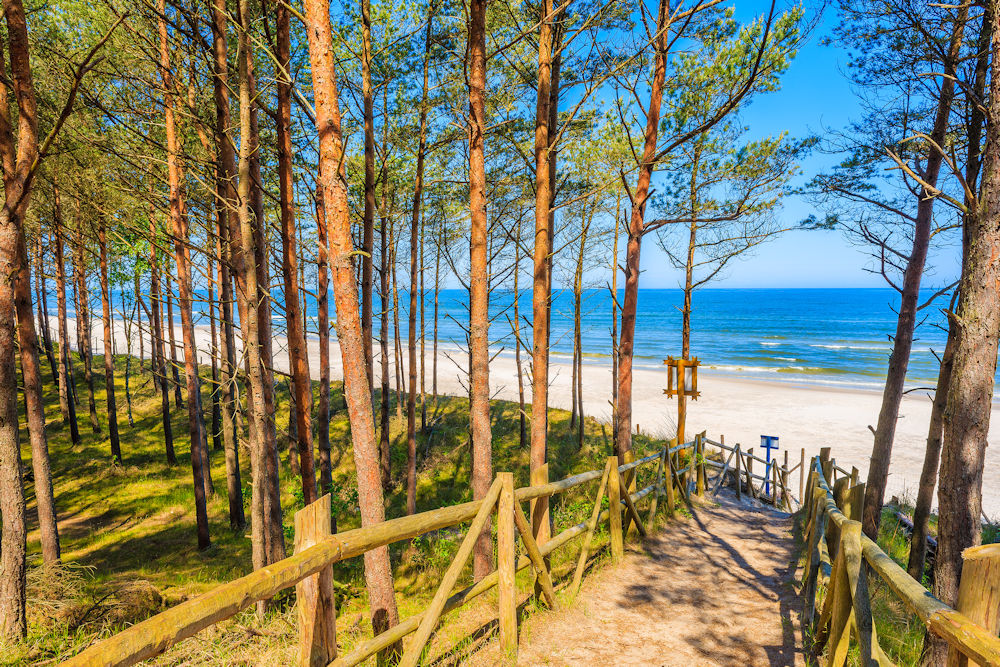Lubiatowo
Lubiatowo is a village located in Pomeranian province, Choczewo district. There is 2 km wide forest belt separating the village from the sea. If you are looking for a quiet place to rest – Lubiatowo is perfect for you: a clean and beautiful beach, picturesque forests with plenty of berries and mushrooms, excellent bike and walking routes. Lubiatowo is a guarantee of calm and peaceful holidays away from the city noise.

Attractions in Lubiatowo
Manor-grange complex and parks
In the south-east part of the village remained XIXth century grange with a manor and 2 outbuildings. More: Natural Monument, ashes covered with ivy, yews. There are many manors and palaces close to Lubiatowo:Choczewo - manor-park complex with a palace and a park dated XIX century.Sasino - manor-park complex (Sasinko), includes a manor (XIX century) and landscape park (very English-like)Sarbienino - manor-park complex with a court built in Tuscan style at the end of XIX century, park with very old trees and ponds.
Zwartowo - manor-park complex, with a palace dated XIX/ XX century and park (established in the 2nd half of the XIXth century) which uses the variety of landscape.
A stud in Lubiatowo
During summer there is a nstud functioning, it offers:
- for beginners – horse riding classes
- for advanced riders – rips,
- for children – pony rides
Such rides can vary the stay for children. Trips are organised in forests, but they also include visiting the beach.
Contact: tel. 58 67 63 159, 504 43 50 60
Stilo Lighthouse
It was built by Germans on concrete and white granite foundations. It was installed from ready-made elements. There ate only 3 such lighthouses – 2 in Europe. At first the lights were gas-powered (burner, mirrors and prisms) then it was changed (a bulb, mirrors and prisms). For about 15 years now, halogen lamps have been used (power 1 200W/12V, emergency generator, and batteries – power reserve for 18 hours). Turning on the lights can be done manually and automatically. In the past there was also sound signal (30 sec. long). It was heard from 6-12 miles distance in a foggy day. As soon as radar for boats was introduced, the sound signal was stopped.
Stilo is opened for tourists from 1.06. to 31.08. between 10.00 and 18.00
Cycle and walking routes
A path ‘Szklana Huta’ is located near the forester Szklana Huta and intended only for walking routes. It includes 12 stops where you can learn more about the forest, its importance and the processes taking place in it, about the work of foresters, their methods and goals that they pursued. Also, with your own eyes can see examples of their activities. And many, many more.
Trails:
Green - length - 10 km, runs around Lake Choczewskie, swerves to Starbienina.
Yellow - 9 km long; starts just behind Choczewo and goes through Kierzkowo to Szklana Huta direction, where the it cuts the blue trail. Ends in a forest on the border Krokow district.
Blue - is 13 km long; it starts at the parking lot just behind Osieki (here you can leave your car and change to the bike). It goes to natural-forest path, and further north near dune Lubiatowska, along the sea shore, through Lubiatowo and Kopalino, and finally connects to the yellow trail.
Orange - is 22.5 km long; it begins at the Amber Promenade, Amber (a route for walkers and cyclists linking the villages Kopalino and Lubiatowo) and leads through the agriculture villages: Kopalino, Sasino and Słajszewo
Barrows near the Lodge Szklana Huta
Barrow - the type of tomb, cone-shaped mound with elements of wood, stone or wood and stone where a burial took place. In Szklana Huta there was the old burial ground discovered by archaeologists during excavations in the 70's. There were located dozens of box-graves, of which three were uncovered. There were found face ashtrays containing human remains. Face ashtrays are pear-shaped vessels with smooth surfaces, with engraved faces. Ashtray was covered with a bowl-like hat. These findings come from a period when people of Slavonic Pomeranian culture were living there/ Iron Age: 650 - 125 BC/. Ashtrays can be seen the Archaeological Museum in Gdansk. Similar barrows are located in neighboring Kopalino
Other attractions
Slowinski National Park, the dunes, sands in Łeba, cruise on the sea, cruise on the lake Łebsko, Żarnowiec and lake Żarnowieckie, Puck Bay, etc.